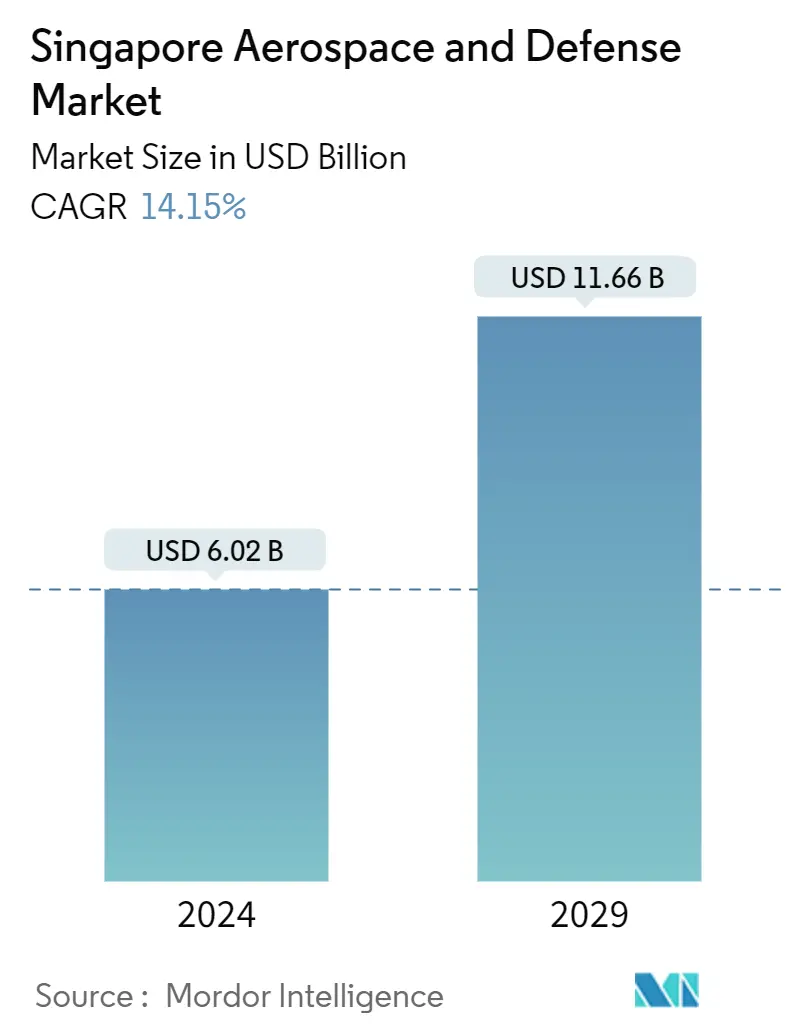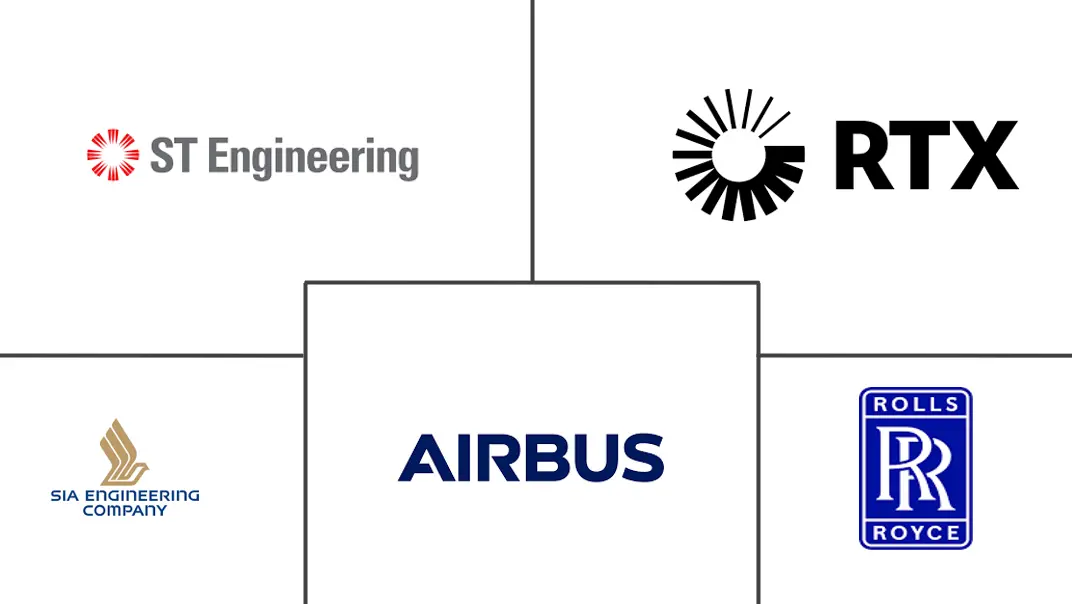Market Size of Singapore Aerospace And Defense Industry

| Study Period | 2019 - 2029 |
| Base Year For Estimation | 2023 |
| Market Size (2024) | USD 6.02 Billion |
| Market Size (2029) | USD 11.66 Billion |
| CAGR (2024 - 2029) | 14.15 % |
| Market Concentration | Low |
Major Players
*Disclaimer: Major Players sorted in no particular order |
Need a report that reflects how COVID-19 has impacted this market and its growth?
Singapore Aerospace & Defence Market Analysis
The Singapore Aerospace And Defense Market size is estimated at USD 6.02 billion in 2024, and is expected to reach USD 11.66 billion by 2029, growing at a CAGR of 14.15% during the forecast period (2024-2029).
The aviation industry is a significant contributor to Singapore's economy, contributing 3% to the country’s GDP in 2022. Singapore Airlines is the flag carrier of the country, operating a fleet of 150 aircraft as of September 2023, with more than 90 aircraft on order. The average age of the aircraft in the carrier’s fleet is around 7.1 years, and it has been constantly reducing for the past five years, with the introduction of new aircraft.
Also, the growth in military expenditure to strengthen the country's air, land, and sea capabilities with the acquisition of aircraft, naval vessels, unmanned vehicles, etc., in the coming years is expected to accelerate the growth of the market. According to the Stockholm International Peace Research Institute (SIPRI), the military expenditure of the country was USD 11.7 billion in 2022.
The aerospace and defense industry in Singapore is expected to grow rapidly because of factors like the growing FDIs. The increasing participation of private companies and startups in space technology is also expected to drive the growth of the market. On the other hand, due to the widespread disruption in the supply chain, some defense programs may face minor cost escalations and delays which can be act as a restraint in the short term.
Singapore Aerospace & Defence Industry Segmentation
The report on Singapore's aerospace and defense market covers the latest trends, technological developments, innovations, investments, import and export scenarios, etc. The report covers international collaborations, partnerships, weapon and defense equipment development, space programs, and other important factors that impact the defense and aerospace industry of Singapore.
The Singapore aerospace and defense market is segmented by industry and type. By industry, the market is segmented by design and engineering, manufacturing, and maintenance, repair, and overhaul. By type, the market is segmented into aerospace and defense. For each segment, the market sizing and forecasts have been done based on value (USD).
| Industry | |
| Manufacturing, Design, and Engineering | |
| Maintenance, Repair, and Overhaul |
| Type | |
| Aerospace | |
| Defense |
Singapore Aerospace And Defense Market Size Summary
The Singapore Aerospace and Defense Market is projected to experience significant growth in the coming years. This growth is attributed to the expansion of the aviation industry, which is a major contributor to the country's economy, with Singapore Airlines being a key player. The market is also fueled by an increase in military expenditure to enhance the country's air, land, and sea capabilities, including the acquisition of aircraft, naval vessels, and unmanned vehicles. The industry's growth is further propelled by increasing foreign direct investments and the participation of private companies and startups in space technology. The market is dominated by the Maintenance, Repair, and Overhaul (MRO) segment, with Singapore being a leading MRO hub for airlines in the Asia-Pacific region. The country's rapid economic growth and the rising popularity of low-cost carriers are boosting passenger traffic and aircraft movements, which in turn is spurring the demand for MRO services. The defense sector is also set to show significant growth due to investment in improving defense capabilities in response to increasing threats. The market consists of more than 120 aerospace companies, with several new entrants offering aerospace design and manufacturing operations.
Explore MoreSingapore Aerospace And Defense Market Size - Table of Contents
-
1. MARKET DYNAMICS
-
1.1 Market Overview
-
1.2 Market Drivers
-
1.3 Market Restraints
-
1.4 Porter's Five Forces Analysis
-
1.4.1 Threat of New Entrants
-
1.4.2 Bargaining power of Buyers/Consumers
-
1.4.3 Bargaining Power of Suppliers
-
1.4.4 Threat of Substitute Products
-
1.4.5 Intensity of Competitive Rivalry
-
-
-
2. MARKET SEGMENTATION
-
2.1 Industry
-
2.1.1 Manufacturing, Design, and Engineering
-
2.1.2 Maintenance, Repair, and Overhaul
-
-
2.2 Type
-
2.2.1 Aerospace
-
2.2.2 Defense
-
-
Singapore Aerospace And Defense Market Size FAQs
How big is the Singapore Aerospace And Defense Market?
The Singapore Aerospace And Defense Market size is expected to reach USD 6.02 billion in 2024 and grow at a CAGR of 14.15% to reach USD 11.66 billion by 2029.
What is the current Singapore Aerospace And Defense Market size?
In 2024, the Singapore Aerospace And Defense Market size is expected to reach USD 6.02 billion.
